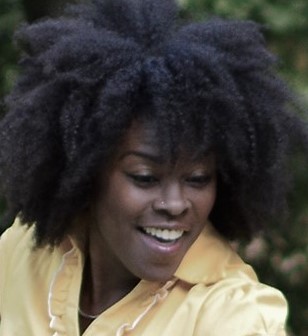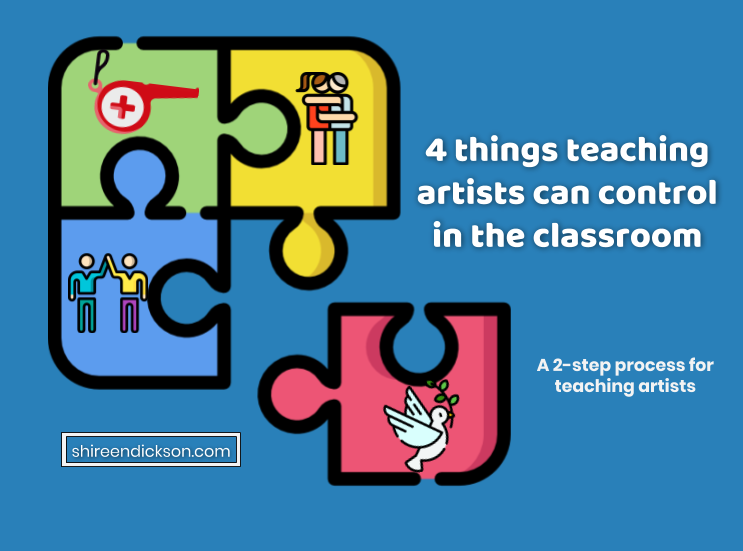Teaching artists: minimize unpredictability throwing you off your game by incorporating these four practices into your lesson plans!
Forget about what you can’t control in the classroom.
The student teacher forgot to tell the custodian that your class moved to the cafeteria because of testing. And now there’s globs of sticky and crumbs of yuck all over five minutes before you’re about to begin.
No one can find the supplies that were shipped for your class.
There were train delays so you didn’t have a chance to get your energy smoothie before class.
You’re so exhausted you could barely get out of bed this morning. If you weren’t behind on your rent…
$h!t happens.
But as Teflon Teaching Artists we can minimize the effects of external factors (including our own artist moodiness) throwing us off our game. Here are four simple things you should keep consistent when everything else is fluctuating, so the chaos doesn’t transfer to them.
Think these strategies through beforehand, and you’ll always be equipped to effortlessly deliver your awesomeness and shielded from the day’s dysfunction.
The 4 things you can control as a teaching artist:
1. Class Rituals
A ritual is a ceremonial act that always follows a prescribed order.
The biggest ritual that teaching artists facilitate is what actually happens in the class – the lesson plan.
A teaching artist lesson plan should always include a warm-up, central activity, and group share/explore (I include standard closing rituals in this final category).
Remember those viral videos of classroom teachers having an individual handshake for each student that they performed every morning? Your rituals do not have to be that elaborate, but they should always simultaneously reinforce a connection to others/the “outside” world and honor the individual where they are.
Here is a chart of example rituals for four common teaching artist disciplines:
|
Discipline |
Warm-up |
Main Activity |
Group/Closing |
|---|---|---|---|
|
Discipline |
Warm-up |
Main Activity |
Group/ Closing |
|
DANCE |
10 deep breaths as a group |
A student demonstrates a dance they found on youtube |
Everyone touches each others shoulders |
|
VISUAL ARTS |
2-minute silent sketch of your day on post-it |
Rotating students responsible for organizing supplies |
Students told to look for an artistic quality in an everyday object between sessions |
|
MUSIC |
Welcome class into space with clapping call and response |
Introduce an odd historical figure or fact |
1-minute goodbye jam session |
|
THEATER |
Students “leave their drama at the door” in a physically symbolic way |
Students improv a scene from their classroom that week |
Always ask the same reflection question |
2. Emergency Preparedness
Being extra prepared is another secret teaching artist weapon. Your lesson plans are the step-by-step directions of the curriculum road map, but you also need some pull-it-outta-your-@$$ tricks that look like “you meant to do that” all the while.
Expect the unexpected, and create a few templates of activities for your discipline that can handle common unexpecteds like managing a class hopped up on cupcakes, a lack of adequate materials or space, or time limitations.
It’s reasonable(?) to expect a classroom teacher to cue a video or hand out worksheets or assign silent reading when outside forces are affecting the plan (or when they just need a break). But teaching artists need to have alternatives that are more aligned with the unique experience they are bringing.
An easy way to start stocking your Emergency Preparedness toolbox is to tweak theater games to your art form.
Examples
Every once in a while I’ll bring out my Dance Quiz (usually with middle-schoolers in afterschool). I keep a copy of random multiple-choice questions on handy that I ask quiz show style. They can debate but can’t use the internet. Sometimes we discuss the answers and sometimes I offer some random prize, but that’s not the point.
When I first mention it, the class gets all like “What? You can’t give us a quiz! You didn’t tell us about no quiz!” And that’s one of the reasons it works – it’s unexpected.
Here are some Dance Quiz question examples – let me know how you did in the comments (and what disciplines you work in)!
DANCE QUIZ
How many foot positions are there in classical ballet?
a. Three b. Five c. Seven d. Ten
What artistic style was NOT developed in the United States?
a. Jazz b. Tap c. Salsa d. Tango
Maculele is a movement form from what country?
a. Spain b. Portugal c. Italy d. Brazil
What line dance is regularly done at black family reunions and weddings?
a. Slip n Slide b. New Jack Slide c. Electric Slide d. Slide to the Left
The polka is a dance form from what country?
a. Germany b. Croatia c. Poland d. Russia
Which is a NOT a dance from the 1960’s?
a. Jerk b. Swim c. Twist d. Pigeon
Which of the following is a percussive dance style?
a. Ballet b. Theater c. Tap d. Modern
Your emergency activities should:
- Be a departure from the usual class fare, to keep it “special”
- Allow students to be social – or not – at their own pace
- Be able to happen in any space, at any time
- Provide additional lens or new learning pathway to art form
3. Your Energy
Get enough sleep. Hydrate. Your muscles and brain need fuel, nourishing and whole foods to process all those creative synapses. Don’t underestimate the effects of ignoring the physical on the success of your class.
Feed your artistic child. Sometimes as teaching artists we forget about the “artist” part of that compound word. Make sure that if the work isn’t giving it to you, you are sourcing inspiration daily. Calm the f#!k down. Breathe deeply. Find the meditation in a mundane, repetitive activity (like watching sleet fall) if the transcendental style is a challenge.
Remember, the class will subtlely mimic your energy. Figure out what tools in your garage will keep that joy consistent every class.
4. Empathy
Have a deep awareness of who your participants are. Truly understand where they are coming from, anticipate those needs and teach accordingly. This might mean brushing up on human developmental stages (so that you smile encouragingly and give that 75 year old time to talk for 30 minutes about how that guitar chord reminds her of a pet canary she had when she was twelve). Or, doing character relay races from wing to wing for 30 minutes with 1st graders if they no longer have an official gym period.
It also means showing that you care about your participants as people. Learning and calling participants by their names is an act of empathy – you are recognizing that an individual is worth being titled and not just part of the group. (I wish every teaching artist did this – NO excuse not to!).
Remembering details shows empathy.
I pick one detail to remember about every class and ask them about it, i.e. “how did the spelling test go?” or “I saw sriracha chicken fingers on the menu for lunch today – yum!”
Empathy is also created by humanizing yourself. In the age of social media where (over)sharing is the norm and you can google personal details about almost anyone’s life, it’s much easier for kids to see their teachers as “people” who have lives outside of the classroom. Share a quick story about you life and use it to demonstrate commonalities or contrasts.
Summary
Think through all things out of our control when we teach. How do you currently handle unexpected events? What else do Teflon Teaching Artists do to make sure that the effectiveness of their work with participants never suffers?
[Sassy_Social_Share align=”center” title=”Share and/or follow, if you please!”]
I’m excited about what you’re writing
I truly do want to hear from you! I appreciate any opportunity to pontificate on these subjects. Or, if I can help in any way, let me know.
Your nameEmail AddressMessageSend message

No responses yet